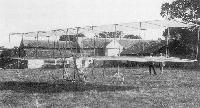
Описание
Страна: Великобритания
Год: 1907
S.Ransom, R.Fairclough English Electric Aircraft and their Predecessors (Putnam)
Moore-Brabazon Powered Glider
Inspired by the gliding of Archdeacon and Farman, J.T.C. Moore-Brabazon decided, on his return from France in the early autumn of 1907, to put his own ideas into practice. Armed with sketches for a glider with wings of about 25 ft span and a heavily cambered section, he asked the Short brothers, Oswald and Eustace, to undertake its construction. For ?25 they produced a well-built aircraft of ash and bamboo with varnished balloon fabric covering the wings. They also took the opportunity to modify the original design, the result being that it appeared with a larger span and almost flat wings. The glider was controlled by a forward elevator mounted on triangulated outriggers, and drag-plate rudders attached to the outermost rear interplane struts. Landing skids and four jettisonable wheels comprised the undercarriage. On completion at the Short's Battersea works, the glider was taken to Brooklands and there housed in a shed alongside that of AV. Roe's.
A few tests were made with the glider, but it was soon decided to fit a 24 hp eight-cylinder Buchet engine. In May 1908, Moore-Brabazon asked Howard Wright to make the required alterations for the engine. By the time Howard had completed his task at Brooklands, very little of the original glider was recognisable, although the 35 ft span wings were used without structural change. The modified aircraft retained the forward elevator, now carried on outriggers level with the lower wings, but was fitted with a fixed tail level with the upper wing. The engine drove a small-diameter pusher propeller with four paddle-shaped aluminium blades. The undercarriage, redesigned to have four castor-action wheels, was to prove the design's undoing for it was found to be weak and unsteady. The inadequate power of the engine also did not contribute to its success. Consequently, the biplane was not tested to any degree but remodified and flown as a kite by Moore-Brabazon at Chelmsford in Essex.
Описание:
- S.Ransom, R.Fairclough English Electric Aircraft and their Predecessors (Putnam)
- M.Goodall, A.Tagg British Aircraft before the Great War (Schiffer)
- P.Lewis British Aircraft 1809-1914 (Putnam)
Фотографии
-
M.Goodall, A.Tagg - British Aircraft before the Great War /Schiffer/
Moore-Brabazon glider built by Short Bros, in 1907 was unsatisfactory on test.
-
P.Lewis - British Aircraft 1809-1914 /Putnam/
Moore-Brabazon biplane. The glider was modified and fitted with an engine by Howard Wright. The undercarriage failed on test on the Finishing Straight at Brooklands.


